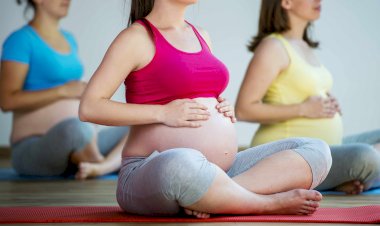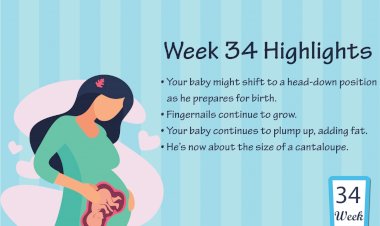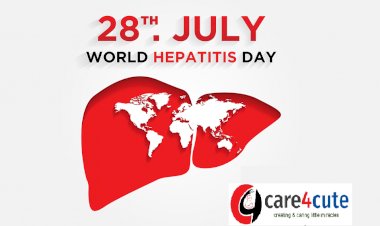Exercise During 1st Trimester of Pregnancy

The more active and fit you are during pregnancy, the easier it will be for you to adapt to your changing shape and weight gain. It will also help you to cope with labour and to get back into shape after the birth. Keep up your normal daily physical activity or exercise (sport, dancing or just walking to the shops and back) for as long as you feel comfortable. Don’t exhaust yourself, and remember that you may need to slow down as your pregnancy progresses or if your doctor advises you to. As a general rule, you should be able to hold a conversation as you exercise. If you become breathless as you talk, then you are probably exercising too strenuously.
If you were inactive before you were pregnant, don’t suddenly take up strenuous exercise. If you start an aerobic exercise programme, begin with no more than 15 minutes’ continuous exercise, three times per week. Increase this gradually to a maximum of 30-minute sessions, four times a week. Inform the instructor that you are pregnant.
Exercise doesn’t have to be strenuous to be beneficial Just 20-30 Minutes of Morning or evening walk every day is sufficient to tune up the energy level. But it is necessary to perform as routine because if you do it once in a week or fortnightly you will not able to cope up with exercise and energy loss.
In Case if you are not comfortable while doing this then it's better to drop it. Sidestep any vigorous exercise and try that you warm up and cool down in common way. Ensure plenty of fluid to maintain the PH level, BP.
It is also ensured while joining any class for doing exercise; your guide must be well qualified and must be well experienced too to avoid any extra stress or cramp during your pregnancy period
Some women also like swimming while pregnancy period, because swimming is the best exercise to tuneup of body and you will feel comfortable while doing exercise. But it must be ensured that you must join a special class with qualified instructors.
Exercises for Pregnancy Period:
Try to fit these exercises into your daily routine. They will strengthen your muscles so that you can carry extra weight, make your joints stronger, improve your circulation, ease backache and generally make you feel well.
Stomach-strengthening exercises
These strengthen your stomach (abdominal) muscles and ease backache, which can be a problem in pregnancy. As your baby gets bigger you may find that the hollow in your lower back becomes more pronounced, which can lead to backache.
- Start in a box position (on all fours), with your knees under your hips, your hands under your shoulders, your fingers facing forward and your stomach muscles lifted so that your back is straight.
- Pull in your stomach muscles and raise your back up towards the ceiling, curling your trunk and allowing your head to relax gently forward. Don’t let your elbows lock.
- Hold for a few seconds then slowly return to the box position.
- Take care not to hollow your back – it should always return to a straight or neutral position.
- Do this slowly and rhythmically 10 times, making your muscles work hard and moving your back carefully. Only move your back as far as you can comfortably.
Pelvic tilt exercises:
Stand with your shoulders and bottom against a wall. Keep your knees soft. Pull your belly button towards your spine, so that your back flattens against the wall. Hold for four seconds and release. Repeat up to 10 times.
Pelvic floor exercises
Pelvic floor exercises help to strengthen the muscles of the pelvic floor, which are placed under great strain in pregnancy and childbirth.
The pelvic floor consists of layers of muscles which stretch like a supportive hammock from the pubic bone (in front) to the base of the backbone. During pregnancy, you may find that you leak urine when you cough or strain. This is known as stress incontinence of urine and it can continue after pregnancy. By performing pelvic floor exercises, you strengthen the pelvic floor muscles and this helps to reduce or avoid this problem after pregnancy. It is important to do them even if you are young and not suffering from stress incontinence now.
- Close up your back passage as if trying to prevent a bowel movement.
- At the same time, draw in your vagina as if you are gripping a tampon, and your urethra as if to stop the flow of urine.
- First do these exercise quickly – tightening and releasing the muscles straight away.
- Then do it slowly, holding the contractions for as long as you can before you relax. Try to count to 10.
- Try to do three sets of eight squeezes every day. To help you remember, you could do them once at each meal. As well as these exercises, you will also need to practice tightening up the pelvic floor before and during coughing and sneezing. Take advice from your doctor about these exercises. Your local maternity unit should run classes where a specialist physiotherapist attends. They can instruct you in groups or individually. Feel free to ask them for advice and help
Foot exercises
Foot exercises can be done sitting or standing. They improve blood circulation, reduce swelling in the ankles and prevent cramp in the calf muscles.
- Bend and stretch your foot vigorously up and down 30 times.
- Rotate your foot eight times one way and eight times the other way.
- Repeat with the other foot. To protect your back.
- Sit up straight with your bottom against the back of your chair. Tuck a small cushion behind your waist if you wish.
- When you pick something up, bend your knees, not your back.
- Try to stand tall.
Exercises to avoid
- Lying flat on your back – particularly after 16 weeks. The ‘bump’ presses on the big blood vessels and can make you feel faint.
- Contact sports where there is a risk of being hit, such as kickboxing, judo or squash.
- Horse riding, downhill skiing, ice hockey, gymnastics, and cycling, because there is a risk of falling.
- Scuba diving, because the baby has no protection against decompression sickness and gas embolism.
- Exercising at heights over 2,500 meters until you have acclimatized. This is because you and your baby are at risk of acute mountain sickness (decrease in oxygen).



































Comments (0)